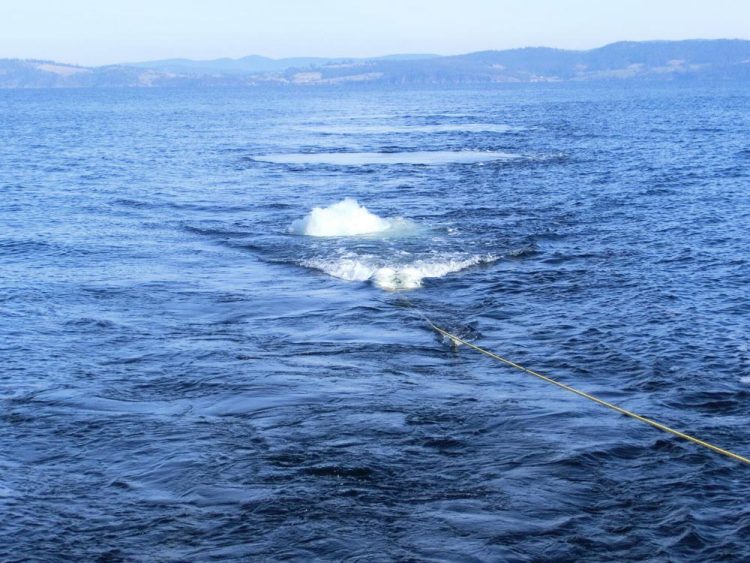New research reveals impact of seismic surveys on zooplankton

This is an air gun test in Storm Bay, Tasmania. Credit: Rob McCauley
Scientists from IMAS and the Centre for Marine Science and Technology (CMST) at Curtin University studied the impact of commercial seismic surveys on zooplankton populations by carrying out tests using seismic air guns in the ocean off Southern Tasmania.
The research found that the air gun signals, commonly used in marine petroleum exploration, had significant negative impact on the target species, causing an increase in mortality from 18 per cent to 40-60 per cent.
Impacts were observed out to the maximum 1.2 kilometre range tested, 100 times greater than the previously assumed impact range of 10 metres, and all larval krill in the range were killed after the air gun's passage.
Lead author, Curtin University and CMST Associate Professor Robert McCauley, said the results raise questions about the impact of seismic testing on zooplankton and the ocean's ecosystems more widely.
“Zooplankton underpin the health and productivity of global marine ecosystems and what this research has shown is that commercial seismic surveys could cause significant disruption to their population levels,” Associate Professor McCauley said.
The study, jointly funded by Curtin University and the University of Tasmania, involved two replicated experiments carried out on consecutive days using a 1.6km survey line in Storm Bay, southern Tasmania.
IMAS Associate Professor and research co-author Jayson Semmens said a series of sonar lines run perpendicular to the air gun line were monitored prior to, and immediately after the air gun run.
“These sonar runs 'imaged' the zooplankton, and showed a lowered zooplankton presence starting 15 minutes after the air gun passed, with a large 'hole' in the zooplankton evident 30 minutes after the air gun pass,” Associate Professor Jayson Semmens said.
This 'hole' or region of lowered zooplankton presence was symmetric about the air gun line and increased through time.
The abundance levels of living and deceased zooplankton were also tested in the same area, before and after the seismic survey testing.
“We counted the number of live and dead zooplankton collected in nets using a special staining technique and found that two to three times as many zooplankton were dead following the air gun operations than those collected before,” Associate Professor Semmens said.
Associate Professor McCauley said he hoped the research would prove useful in assisting regulatory authorities to monitor and manage marine seismic survey operations, in understanding how these surveys impact marine systems and how we may reduce such impacts.
“Plankton underpin whole ocean productivity,” Associate Professor McCauley said. “Their presence impacts right across the health of the ecosystem so it's important we pay attention to their future.”
Media Contact
All latest news from the category: Life Sciences and Chemistry
Articles and reports from the Life Sciences and chemistry area deal with applied and basic research into modern biology, chemistry and human medicine.
Valuable information can be found on a range of life sciences fields including bacteriology, biochemistry, bionics, bioinformatics, biophysics, biotechnology, genetics, geobotany, human biology, marine biology, microbiology, molecular biology, cellular biology, zoology, bioinorganic chemistry, microchemistry and environmental chemistry.
Newest articles

Pinpointing hydrogen isotopes in titanium hydride nanofilms
Although it is the smallest and lightest atom, hydrogen can have a big impact by infiltrating other materials and affecting their properties, such as superconductivity and metal-insulator-transitions. Now, researchers from…

A new way of entangling light and sound
For a wide variety of emerging quantum technologies, such as secure quantum communications and quantum computing, quantum entanglement is a prerequisite. Scientists at the Max-Planck-Institute for the Science of Light…

Telescope for NASA’s Roman Mission complete, delivered to Goddard
NASA’s Nancy Grace Roman Space Telescope is one giant step closer to unlocking the mysteries of the universe. The mission has now received its final major delivery: the Optical Telescope…



